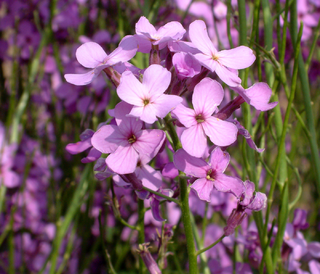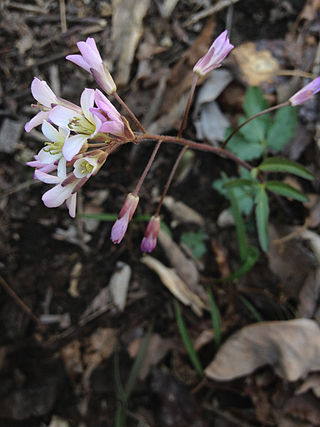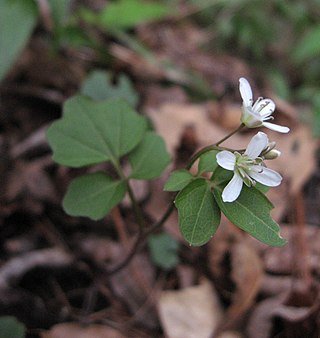
Watercress or yellowcress is a species of aquatic flowering plant in the cabbage family Brassicaceae.

Hesperis matronalis is an herbaceous flowering plant species in the family Brassicaceae. It has numerous common names, including dame's rocket, damask-violet, dame's-violet, dames-wort, dame's gilliflower, night-scented gilliflower, queen's gilliflower, rogue's gilliflower, summer lilac, sweet rocket, mother-of-the-evening, Good & Plenties, and winter gilliflower.

Cardamine is a large genus of flowering plants in the mustard family, Brassicaceae, known as bittercresses and toothworts. It contains more than 200 species of annuals and perennials. Species in this genus can be found in diverse habitats worldwide, except the Antarctic. The name Cardamine is derived from the Greek kardaminē, water cress, from kardamon, pepper grass.

Cardamine hirsuta, commonly called hairy bittercress, is an annual or biennial species of plant in the family Brassicaceae, and is edible as a salad green. It is common in moist areas around the world.

Cardamine concatenata, the cutleaved toothwort, crow's toes, pepper root or purple-flowered toothwort, is a flowering plant in the family Brassicaceae. It is a perennial woodland wildflower native to eastern North America.

Erigenia bulbosa, also known as harbinger of spring or pepper and salt, is a flowering perennial plant in the family Apiaceae. E. bulbosa is the only species in the genus Erigenia and tribe Erigenieae. This plant is known as harbinger of spring because it is one of the earliest blooming native wildflowers of rich forests in the mid-latitude United States. Throughout most of its range it blooms from late February through early April.

Cardamine diphylla is a flowering plant in the family Brassicaceae. It is a spring flowering woodland plant that is native to eastern North America.

Butomus is the only known genus in the plant family Butomaceae, native to Europe and Asia. It is considered invasive in some parts of the United States.

Poa bulbosa is a species of grass known by the common names bulbous bluegrass or bulbous meadow-grass. It is native to Eurasia and North Africa, but it is present practically worldwide as an introduced species. It is widespread in the United States and southern Canada. It was introduced to the eastern United States around 1906 and the western US in 1915 as a contaminant in shipments of alfalfa seed. It was intentionally planted on both the east and west coasts to control weeds and prevent erosion. Today it is a common grass across the continent and is a noxious weed in some areas. It is a sturdy, hardy, persistent, aggressive grass that easily outcompetes many other plants and becomes the dominant species in disturbed habitat types, such as overgrazed fields.

Cardamine corymbosa, commonly known as the New Zealand bitter-cress, is a flowering plant in the family Brassicaceae. Native to the subantarctic islands of Australasia, it has become an invasive species in plant nurseries. The specific epithet refers to the structure of the inflorescence.

Cardamine angustata is a perennial forb native to the eastern United States, that produces white to pink or purple flowers in early spring.

Cardamine douglassii, the limestone bittercress or purple cress, is a perennial forb native to the eastern and central United States as well as the province of Ontario in Canada, that produces white to pink or purple flowers in early spring.
Packera cardamine is a species of flowering plant in the aster family known by the common name bittercress ragwort.

Arabis caucasica is a species of flowering plant in the mustard family (Brassicaceae) known by the common names garden arabis, mountain rock cress or Caucasian rockcress.

Lepidium coronopus,, is a species of flowering plant in the mustard family which is native to parts of Africa, western Asia and Europe, growing in shingle banks, wasteland or cultivated fields.

Cardamine flagellifera, commonly known as Blue Ridge bittercress, is a species of herbaceous plant in the mustard family. It is native to eastern North America, where it is found primarily in the southern Blue Ridge. It is a perennial that produces white flowers in the spring.

Boechera retrofracta is a species of flowering plant in family Brassicaceae. The common names include reflexed rockcress.
Cardamine dissecta is a species of flowering plant in the mustard family Brassicaceae.


















